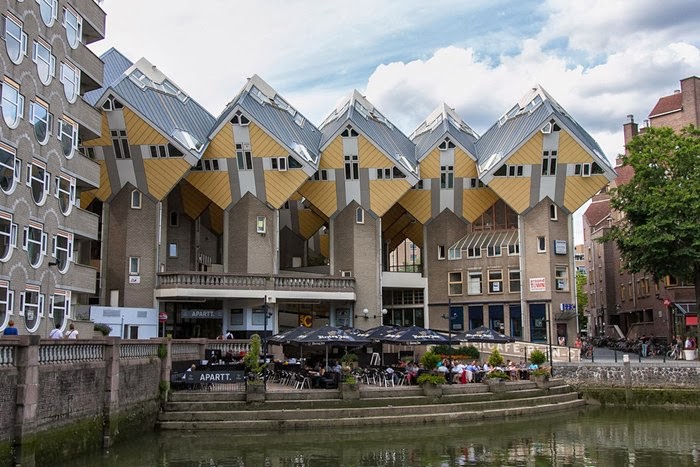Rotterdam Cube Houses — Holland
Photo — Link
Structurally, the cubes sit tilted on a hexagonal pole. They are made up
of concrete floors, concrete pillars and wooden framing. Inside, the
houses are divided into three levels accessed via a narrow staircase.
The lower level is a triangular area used as the living room. The middle
level houses the sleeping and bathing area, and the highest level is a
spare area used either as a second bedroom or another living area.
Rotterdam Cube Houses — Holland 

Photo — Link
Completing the tilted design, the walls and windows are all angled at
54.7 degrees, providing excellent views of the surrounding area. The
only drawback – aside from claustrophobia is that despite a total area
of 100 square meters, the angled structure means only a quarter of that
space is actually usable.
Aside from the uniqueness of the asymmetrical design, the cubic houses
are meant to represent an abstract forest. According to Blom, the
triangular top of each individual house is supposed to represent an
abstract tree, which, when connected with its neighbor, becomes a sea of
trees in a yellow, manufactured forest.
Rotterdam Cube Houses — Holland 

Photo — Link
Rotterdam Cube Houses — Holland
Photo — Link
Rotterdam Cube Houses — Holland
Photo — Link
Rotterdam Cube Houses — Holland
Photo — Link
Rotterdam Cube Houses — Holland
Photo — Link
Rotterdam Cube Houses — Holland
Photo — Link
Rotterdam Cube Houses — Holland
Photo — Link
Rotterdam Cube Houses — Holland
Photo — Link
Rotterdam Cube Houses — Holland
Photo — Link
Rotterdam Cube Houses — Holland
Photo — Link
Rotterdam Cube Houses — Holland
Photo — Link
Rotterdam Cube Houses — Holland
Photo — Link
Rotterdam Cube Houses — Holland
Photo — Link














No comments:
Post a Comment
Note: only a member of this blog may post a comment.